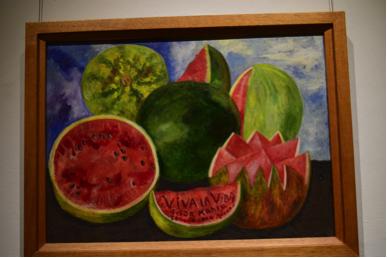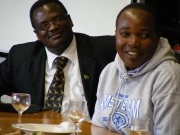Guest blog by Tiziana Lembo and Liliana Salvador with contributions from Rowland Kao and Louise Matthews.
What is the role of scientific conference? Is it to present our research and expound upon our scientific philosophies? Is it to hear people talking about the interesting research that they are developing? Or is it to meet old friends and make new ones while also traveling to interesting places? All of these aims and more were fulfilled when a group of us left umbrellas and raincoats behind to travel to sunny and warm Mérida, Mexico, for two stimulating weeks of ISVEE 14 (International Society for Veterinary Epidemiology and Economics) conference and workshops. The sun, heat, margaritas, “Jarana” tunes and dances, and the colourful decorations of the “Día de Muertos” created an ideal atmosphere for productive and enlightening scientific interactions.

The beginning of ISVEE 14 coincided with the “Dia de Muertos” (Day of the Dead), an ancient Mexican celebration to remember ancestors, family members and friends who have died. Traditionally, altars (“ofrendas”) are built that are laden with decorations, and favourite foods and beverages of teh departed. Above an altar dedicated to the famous Mexican painter Frida Kahlo de Rivera at La Casa Azul in Mexico City, where Frida Kahlo lived and worked most of her life (photo: Tiziana Lembo)
Every three years, ISVEE provides opportunities for academics from a range of different disciplines, policy-makers and stakeholders from the private sector to come together to share their expertise in innovative research, technological developments, and policy health agendas. By blending a wide range of disciplines to address health issues of global importance, the Boyd Orr Centre has a major role to play in all these discussions. What were our contributions to the ISVEE agenda this year?
Let’s start with our research on the very topical bovine Tuberculosis (bTB), caused by Mycobacterium bovis. Rowland Kao discussed a subject that is very close to his heart – the transformative role of Whole-Genome-Sequencing (WGS) in elucidating complex transmission dynamics and disease maintenance patterns in multi-host systems. He provided examples of how the approach has been used by the Glasgow team and collaborators to expose the role of wildlife in the maintenance and transmission of bTB to cattle in different parts of the world, including Great Britain, the United States, and New Zealand. He contrasted currently available data with optimal data and listed some of the key features of an ideal dataset for WGS approaches, most importantly dense, representative sampling across all important hosts; representative samples across populations, but also the way that evolutionary analyses and model-based epidemiological approaches complement each other in interpreting these data.
Joseph Crisp and Liliana Salvador provided examples of the use of WGS to tackle bTB in New Zealand and US wildlife and cattle populations. Joe showed that the evolutionary substitution rates of M. bovis in his study populations, including cattle, possums and other wildlife are higher than previously thought and that non-cattle reservoirs were heavily involved in the maintenance of M. bovis in the sampled population. Liliana focused on bTB transmission amongst elk, deer and cattle in Michigan, US, and demonstrated that elk is the only one of these species with spatial and temporal clustering of M. bovis. In addition, for the available data, she showed that there is no evidence of transmission between elk and cattle and that cross-species transmission in Michigan is likely due to deer.
Liliana also presented her work on surveillance of bTB in Low Risk Areas (LRAs) in England. She showed that larger herds and herds that receive a high number of animals from high-risk areas are most exposed to infection. She also demonstrated that in LRAs there is no clear advantage of testing herds for bTB more frequently, since it would give no increase in the number of detected breakdowns, but the number of false positive would rise considerably. However, adopting risk-based surveillance, where herds that are at higher risk of infection are targeted, can improve the efficiency of the testing regime by increasing the number of identified cases and reducing the number of herds tested.
An entire session of the conference was dedicated to foot-and-mouth disease (FMD) with a focus on the latest research efforts in Africa, Asia and Latin America. The work of the Boyd Orr Centre on endemic FMD in Tanzania featured prominently. Findings from micro-econometric studies investigating impacts of FMD outbreaks on individual livestock-owning communities were presented by Tom Marsh, a collaborator from Washington State University. These analyses have revealed that FMD outbreaks in cattle cause reductions in milk production, traction capacity and income from livestock sales, and that households would spend more on child education if they were not affected by milk losses due to FMD. Tiziana Lembo’s talk focused on epidemiological studies investigating temporal and spatial FMD virus dynamics in East Africa to devise appropriate control strategies. She showed that four different serotypes (A, O, SAT 1 and SAT 2) are responsible for FMD outbreaks in cattle in northern Tanzania, and that there is a pattern of serotypic dominance over time across Tanzania and Kenya, which allows us to predict the timing of epidemics of specific serotypes. The implications are that livestock vaccination could target given serotypes ahead of expected outbreaks, using monovalent vaccines, which are much more readily available than polyvalent vaccines needed to cover all of the wide range of serotypes circulating in these areas.
In her talk, Louise Matthews tackled the question of whether farmers would adopt a new diagnostic test for early detection of sheep scab at the subclinical stage. The advantages of using the test are that it would allow farmers to detect and treat the disease before clinical signs, reducing production losses, and also reducing transmission to other sheep and flocks. However, the farmers would need to pay for the test and may be reluctant to do so if they believe their flock to be at low risk of infection or if their neighbour is using the test, therefore not posing a transmission risk. These advantages and disadvantages can be assessed using a game theory framework that predicts whether farmers will adopt the test and how that uptake depends on test cost. The outcome was uptake of the test when farmers are at high risk (i.e. when they had experienced clinical sheep scab in the previous year), leading in the long term to a reduction in the proportion of infected farms by around 50%.
Harriet Auty, a collaborator from Scotland’s Rural College, presented research on human African trypanosomiasis caused by Trypanosoma brucei rhodesiense in Tanzania. She talked about the relative importance of different wildlife species in the reservoir community for human trypanosomiasis in multi-host populations of the Serengeti National Park. She showed that species such as bushbuck, reedbuck and impala, which are frequently infected with T. brucei, might play an important role in the reservoir community, even though they are not regular food sources for the tsetse vector. Conversely, elephant or giraffe are frequently fed on but rarely infected, indicating they may play a role in dampening transmission, and suggesting how changes in wild species composition could impact on human disease risk.
As always, ISVEE also provided a forum for conference delegates to update and strengthen their skills in a number of methods and topics through workshops run by academic colleagues from around the world. For instance, Tiziana Lembo benefited from training and discussions in data management and analyses in R organised by the Swedish National Veterinary Institute, as well as in the use of economics for animal health decision-making coordinated by the Royal Veterinary College and collaborators.
Back to the rain and grey skies now, we have many memories and knowledge to treasure from the land of revolution, music and art.

Street mural depicting Emiliano Zapata in Tepoztlan, State of Morelos, Mexico during the Mexican Revolution. Zapata remains an iconic figure in Mexico to this day (Photo: Tiziana Lembo).

An ode to life (“Viva la Vida”) by the Mexican painter Frida Kahlo de Rivera, La Casa Azul, Mexico City (Photo: Tiziana Lembo).
The research presented and our attendance were funded by: BBSRC / DFID / Scottish Government (Combating Infectious Diseases of Livestock for International Development initiative), MSD Animal Health, and Scottish Universities Life Sciences Alliance (Tiziana Lembo); BBSRC/DFID (Zoonoses in Emerging Livestock Systems) and EPIC (The Scottish Centre of Expertise in Animal Disease Outbreaks); Defra, NSF/BBSRC



